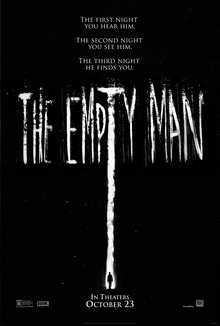American horror films usually follow a very predictable formula: a group of friends encounter a danger in some remote area and are slowly killed off one by one. The Empty Man seems at first like a typical example of the genre but then we learn that it’s just the prologue and the real story starts shortly after. It’s a little longer than typical horror films but it makes excellent use of its running time to deliver a dense plot that is built around a wonderfully rich mythos. This was adapted from a graphic novel series and it does strike me how unlikely that an original horror film script could be allowed to be this complex. Needless to say I loved it and consider one of the best American horror films I’ve seen in a while.
The prologue has four friends hiking in Bhutan come across a not quite human skeleton. Back in the US, James Lasombra is a former police officer who is still grieving for the loss of his wife and child. He is friends with his neighbor Nora and her daughter Amanda. When Amanda goes missing from home with a message in blood saying, “The Empty Man made me do it” is found on her bathroom mirror, James tries to help. He tracks down Amanda’s friends at school and finds one willing to talk. She recounts that a group of them hung out at a bridge a few nights ago and tried summoning a local bogeyman known as the Empty Man by blowing across the lip of a glass bottle. He learns that the name is associated with an organization called the Pontifex Institute which seems like a cult of some kind. When he fails to locate any of the other kids who were there that night, he investigates the bridge and finding the bottle they had left, casually blows on it but nothing happens. On a hunch, he checks out the area underneath the bridge and finds the hanged bodies of the rest of Amanda’s friends there.
This would have been a disappointing film indeed if it played out as a standard horror monster hunts down survivors one by one scenario. Instead this is a framed as an investigation as Lasombra tries to learn what is going on only to find out that the hole goes deeper and deeper. The film is deliberately vague about the extent of the cult’s influence and this works out pretty great. It’s enough to know that the threat goes far beyond just one school or even one town but Lasombra remains focused mostly on finding Amanda. The mantras chanted by the Pontifex Institute, their sermons and even the videotaped evidence of the summoning sessions they hold build up to convincingly complete mythos. We’ve seen elements like children’s superstitions made real, a cult attracting followers by promising release from the miseries of life, a summoning ritual that progressively takes effect over a number of days and so on elsewhere before but it’s really impressive how the film weaves them together into a coherent narrative here. The nihilistic philosophy at the center of the cult is even intellectually consistent and cleverly thought out. It’s brilliant for example to drag out Nietzsche’s old line about staring into the abyss and after acknowledging that it has been overused, infuse it with new power.
The film also does a few other things that I like. Where many horror films prefer to use a female protagonist to highlight her vulnerability, Lasombra is a male former police officer who is portrayed as being practical and competent. He does sensible things like arming himself when he thinks there might be danger and when he reports in to the local police force, they are actually inclined to help him. That the cult is a credible threat to someone like him really helps make them seem more scary. But then the Empty Man specifically preys on people who seek escape from trauma in their lives and Lasombra’s backstory, as we intuit early on, has plenty of tragedy in it. It both gives a strong theme to this particular flavor of horror and does away with the need to make the protagonist make dumb decisions in order to be put in danger.
This film didn’t do too well upon release and apparently director and scriptwriter David Prior was dissatisfied with the editing. I think there are some problems in the timeline after the final twist is revealed as it’s not quite clear what Lasombra really experienced over the course of the three days of his investigation. Even so, this is cleverly plotted film where the beginning is revealed to foreshadow the end and the protagonist has a satisfying emotional arc. Happily the film’s reputation has improved greatly since it has moved to online streaming. I hope the industry recognizes in hindsight that this was a really strong debut for Prior and he gets to work on more cool stuff.

One thought on “The Empty Man (2020)”